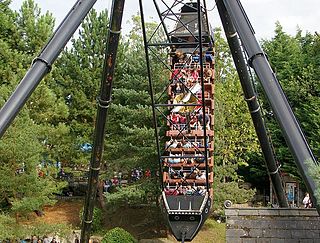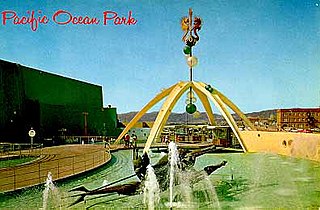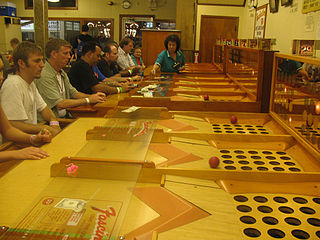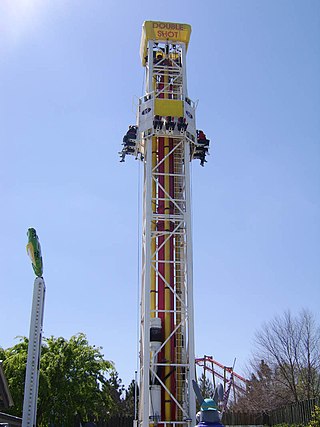
A pirate ship is a type of amusement ride based on pirate ships, consisting of an open, seated gondola which swings back and forth, subjecting the rider to various levels of angular momentum. A variant where the riders must pull on ropes to swing the ride is known as a swing boat.

Pacific Ocean Park was a 28-acre (11-hectare) nautical-themed amusement park built on a pier at Pier Avenue in the Ocean Park section of Santa Monica, California in 1958. Intended to compete with Disneyland, it replaced Ocean Park Pier (1926-1956). After it closed and fell into disrepair, the park and pier anchored the Dogtown area of Santa Monica.
The Santa Cruz Beach Boardwalk is an oceanfront amusement park in Santa Cruz, California. Founded in 1907, it is California's oldest surviving amusement park and one of the few seaside parks on the West Coast of the United States.
Hunt's Pier was an amusement pier located along the Wildwood, New Jersey, boardwalk from 1957 through 1985. Over its nearly 30 years in operation, Hunt's was home to many classic dark rides, roller coasters, and other attractions.

The Musée Mécanique is a for-profit interactive museum of 20th-century penny arcade games and artifacts, located at Fisherman's Wharf in San Francisco, California. With over 300 mechanical machines, it is one of the world's largest privately owned collections.

The Rotor is an amusement ride designed and patented by German engineer Ernst Hoffmeister in 1948. The ride was first demonstrated at Oktoberfest 1949 and still appears in numerous amusement parks. The Rotor is a large, upright barrel, rotated to create an inward acting centripetal force supplied by the wall's support's force. Once at full speed, the floor is retracted, leaving the riders stuck to the wall of the drum.

Fascination is a game commonly found in North American amusement parks, boardwalks and arcades. The game is a redemption game, in that prizes are often won for playing the game. The game dates to 1918, with the first location opening at Coney Island, NY. It became popular during the 1920s and spread quickly from coast to coast, as evidenced in pictures of Chutes at the Beach in San Francisco, a park that operated from 1903 - 1928. Over a century later, there are still a handful of locations that are in operation, mostly in the Northeastern US.
The Pike was an amusement zone in Long Beach, California. The Pike was founded in 1902 along the shoreline south of Ocean Boulevard with several independent arcades, food stands, gift shops, a variety of rides and a grand bath house. It was most noted for the Cyclone Racer (1930–1968), a large wooden dual-track roller coaster, built out on pilings over the water.

Playland was a 10-acre (40,000-square-meter) seaside amusement park located next to Ocean Beach, in the Richmond District at the western edge of San Francisco, California, along Great Highway, bounded by Balboa and Fulton streets. It began as a collection of amusement rides and concessions in the late 19th century, and was preceded by Chutes at the Beach, opened in 1921. Playland closed Labor Day weekend in 1972.

Charles I. D. Looff was a Danish master carver and builder of hand-carved carousels and amusement rides, who immigrated to the United States of America in 1870. Looff built the first carousel at Coney Island in 1876. During his lifetime, he built over 40 carousels, several amusements parks, numerous roller coasters and Ferris wheels, and built California's famous Santa Monica Pier. He became famous for creating the unique Coney Island style of carousel carving.

Galaxi is the common name of a series of mass-produced roller coasters manufactured primarily by Italian company S.D.C, which went bankrupt in 1993. The roller coaster design was first used in the 1970s, and as of 2009, sixteen Galaxi coasters are still in park-based operation, across the North American, European, and Australian continents, with another two "Standing But Not Operating". At least 37 amusement parks are operating or have previously operated Galaxi coasters; this does not include those owned by funfairs and traveling ride companies.
Playland-Not-At-The-Beach was a non-profit, family-oriented museum in El Cerrito, California celebrating America's bygone amusements, operated entirely by volunteers.
Great Old Amusement Parks is a 1999 PBS television documentary VHS DVD produced by Rick Sebak of WQED Pittsburgh which aired on PBS, on July 21, 1999.

Double Shot is a type of amusement ride manufactured by S&S - Sansei Technologies.
Ghost Blasters is an interactive dark ride franchise, designed and created by Sally Corporation. The franchise includes many locations at various amusement parks throughout the United States and Canada. Riders on "Ghost Blasters" are equipped with laser guns, as the attraction travels through a themed "haunted manor". The goal of the attraction is to accumulate a high score by aiming and firing at lit targets.

Jessie's Critter Carousel is a carousel at Disney California Adventure at the Disneyland Resort in Anaheim, California. The attraction opened to the public as King Triton's Carousel of the Sea on February 8, 2001.

Toboggan is a portable roller coaster that was built by Chance Industries from 1969 to the mid-1970s. The coaster features a small vehicle, holding two people, that climbs vertically inside a hollow steel tower then spirals back down around the same tower. There is a small section of track at the base of the tower with a few small dips and two turns to bring the ride vehicle back to the station. Each vehicle has a single rubber tire with a hydraulic clutch braking system that governs the speed of the vehicle as it descends the tower. The rubber tire engages a center rail that begins halfway through the first spiral. The ride stands 45 feet tall with a track length of 450 feet. A typical ride lasts approximately 70 seconds.

Pixar Pier is a themed land at Disney California Adventure, based on that of Victorian boardwalks that were once found along the coast of California. Despite its name and the presence of a nearby human-made lake, Pixar Pier is not actually a pier, but a waterside area of the park. Incredicoaster sprawls across much of the area, with various other attractions and forms of entertainment scattered around it.













